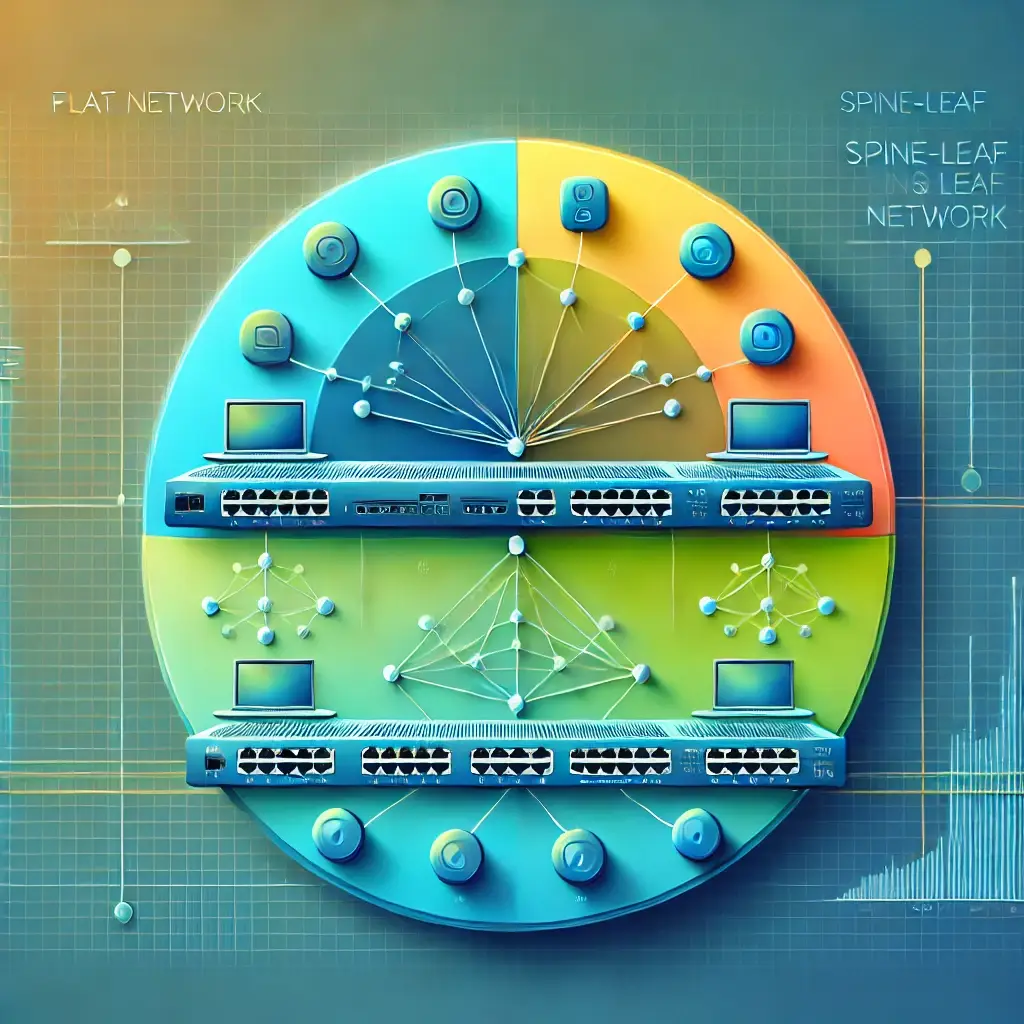While designing a network, picking the right design is a basic choice influencing versatility, execution, and manageability. While looking at the best level of organization versus a spine-leaf network, each offers exceptional benefits and disadvantages, making them fit explicit conditions. In this aid, we’ll investigate the distinctions, and benefits, and use instances of these models to assist you with concluding which is the best for your requirements.
What Is a Flat Network?
A flat network is a solitary-layer plan where all devices are essential for a similar transmission space. Devices communicate directly without hierarchical segmentation, which simplifies setup and maintenance.
Flat networks are commonly utilized in more modest arrangements, like small workplaces or home organizations, where traffic is negligible and the number of gadgets is restricted.
Advantages of Flat Networks
Simplified Configuration: Setting up and keeping a flat network is direct, making it ideal for conditions with restricted IT assets.
Cost-Effective: Requires less switches and negligible equipment, decreasing generally costs.
Low Latency: Direct device connections lead to faster communication in smaller networks.
Disadvantages of Flat Networks
Scalability Issues: The organization can become clogged as additional devices are added, prompting decreased execution.
Broadcast Storms: Since all gadgets share a similar transmission space, inordinate transmission traffic can overpower the organization.
Limited Fault Tolerance: A single failure can disrupt communication across the network.
What Is a Spine-Leaf Network?
A spine-leaf network is a two-tier architecture commonly used in data centers and large-scale networks. It consists of two main components:
- Leaf switches: Connected to servers and endpoints.
- Spine switches: Interconnect all leaf switches, ensuring high-speed data transfer.
This engineering gives a completely coincided plan, where each leaf switch interfaces with all spine switches, guaranteeing overt repetitiveness and ideal execution.
Advantages of Spine-Leaf Networks
High Scalability: Easily supports network growth by adding more leaf or spine switches.
Redundancy: Multiple paths between devices minimize the impact of a single point of failure.
Efficient Load Distribution: Equal-Cost Multi-Path (ECMP) routing ensures traffic is balanced across multiple links.
Low Latency in Large Networks: The two-tier design reduces the number of hops, ensuring fast communication.
Disadvantages of Spine-Leaf Networks
Complex Setup: Requires advanced expertise for configuration and management.
Higher Cost: More hardware and interconnections lead to increased capital and operational expenses.
Flat Network vs. Spine-Leaf Network
While both architectures serve the same fundamental purpose of enabling device communication, their underlying structures make them suitable for different scenarios.
| Feature | Flat Network | Spine-Leaf Network |
| Architecture | Single-layer, no hierarchy | Two-tier, hierarchical |
| Scalability | Limited | Highly scalable |
| Cost | Low | Higher |
| Fault Tolerance | Minimal | High (redundant paths) |
| Use Cases | Small offices, home networks | Data centers, cloud environments |
| Traffic Management | Basic, shared broadcast domain | Advanced, supports ECMP |
When to Choose a Flat Network?
Flat networks are best suited for environments with limited devices and minimal traffic requirements. Examples include:
- Small Offices: Where simplicity and cost savings are priorities.
- Home Networks: Ideal for connecting personal devices like laptops, printers, and smart home gadgets.
- Temporary Setups: Great for event-based networks or quick deployments.
For organizations with limited IT expertise or budgets, a flat network offers a practical solution. However, it’s essential to monitor traffic carefully as growth can quickly strain the network’s capabilities.
When to Choose a Spine-Leaf Network?
Spine-leaf networks are designed for environments that demand high performance, reliability, and scalability. Common use cases include:
- Data Centers: Where large volumes of data need to be processed and transferred quickly.
- Cloud Environments: Supporting virtualized workloads and high availability.
- Enterprises with Growing Needs: For organizations expecting quick development, this design gives a future-evidence arrangement.
On the off chance that uptime, speed, and the capacity to deal with huge scope traffic are basic, the spine-leaf design offers unmatched benefits.
Future Trends in Networking
As innovation advances, so do network designs. Half and half arrangements consolidating components of level and spine-leaf networks are acquiring fame. For example:
- Software-Defined Networking (SDN): Gives unified administration to complex spine-leaf networks, improving activities.
- Edge Computing: Level organizations might coordinate edge gadgets for confined information handling, lessening burden on focal assets.
These innovations ensure that both flat and spine-leaf networks remain relevant in various applications, depending on specific needs.

Which Is the Best Network for You?
The choice between a flat network and a spineless network ultimately depends on your requirements. Consider the following:
- Flat Network: Choose this for small-scale deployments with limited growth potential. It offers simplicity and cost savings but lacks the robustness required for large environments.
- Spine-Leaf Network: Ideal for undertakings and server centers requiring superior execution, adaptation to non-critical failure, and versatility.
By assessing your ongoing framework, traffic requests, and long-haul objectives, you can choose the design that best lines up with your goals.
For more, read: INFIC14
Conclusion
Grasping a flat network vs. a spine-leaf network is vital for pursuing an educated choice. While flat networks succeed in straightforwardness and cost-viability, spine-leaf networks give the versatility and dependability essential for bigger, superior execution conditions.
Whether you’re dealing with a little office or a rambling server farm, the right engineering will improve productivity and back your development. Assess your requirements cautiously, and put resources into an organization plan that engages your tasks.
